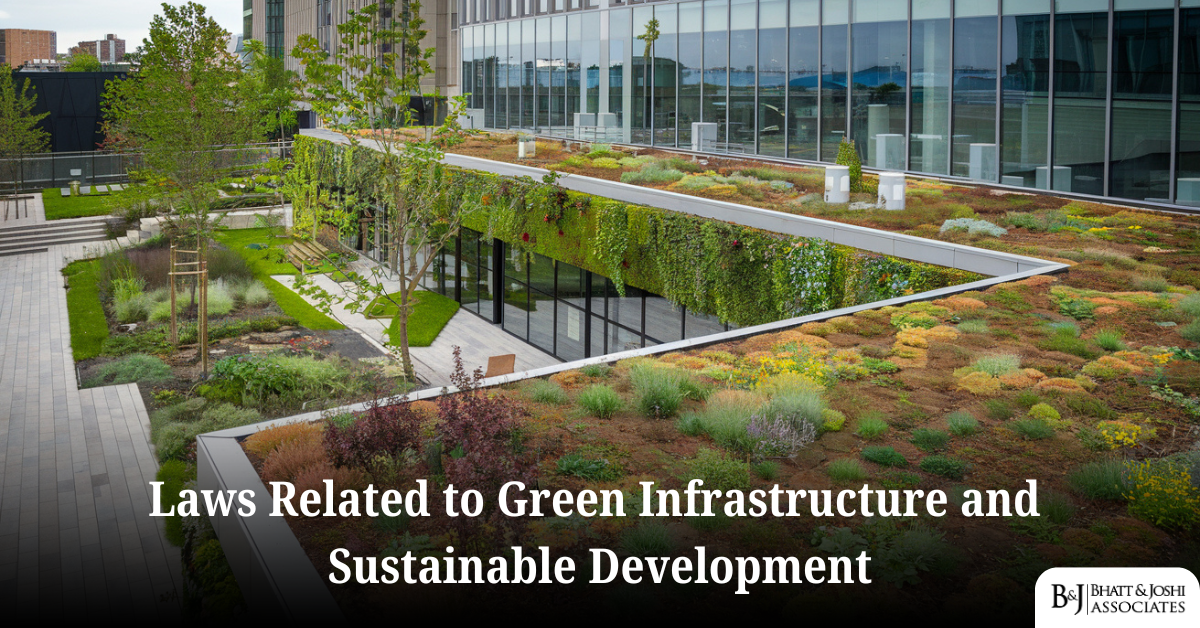Introduction
Green infrastructure and sustainable development have emerged as indispensable components in addressing the global challenges of climate change, urbanization, and environmental degradation. As nations strive to create resilient and sustainable communities, legal frameworks play a crucial role in regulating and promoting green infrastructure initiatives. In India, this agenda has taken center stage with a range of laws, policies, and judicial interventions aimed at balancing economic development with environmental sustainability and social equity. This article delves into the intricate legal landscape surrounding green infrastructure and sustainable development, providing a comprehensive exploration of key laws, case laws, and judgments that shape the implementation of these concepts in India.
Defining Green Infrastructure and Sustainable Development
Green infrastructure refers to a strategically planned network of natural and semi-natural areas designed to provide environmental, economic, and social benefits. It involves the integration of nature into urban settings through elements like green roofs, urban forests, wetlands, parks, and vegetated swales that enhance biodiversity, manage stormwater, and mitigate the impacts of urban heat islands. This form of infrastructure acts as a sustainable alternative to traditional, hard-engineered solutions, offering resilience against climate change while improving the quality of life in urban environments.
Sustainable development, on the other hand, refers to development that meets the needs of the present without compromising the ability of future generations to meet their own needs. It requires a balance between economic growth, social equity, and environmental protection. In India, sustainable development has gained traction following the 1992 Earth Summit, where Agenda 21 was introduced, and the country committed to integrating sustainable practices into its development agenda. These principles have since been enshrined in India’s national policies, legislation, and jurisprudence.
Constitutional Foundation for Environmental Protection
The Indian Constitution provides a robust provision for environmental protection, which indirectly supports the development of green infrastructure and promotes sustainable development. Article 48-A, a part of the Directive Principles of State Policy, directs the state to protect and improve the environment and to safeguard forests and wildlife. Though these principles are not legally enforceable, they guide policymaking and have been instrumental in shaping India’s environmental laws.
Article 51-A(g) of the Constitution imposes a duty on every citizen to protect and improve the natural environment, including forests, lakes, rivers, and wildlife, and to show compassion for living creatures. This constitutional duty is vital in fostering an environmentally conscious society, where individuals are expected to take an active role in environmental stewardship.
Over the years, the judiciary has expanded the interpretation of Article 21, which guarantees the right to life, to include the right to a healthy environment. In the landmark case of Subhash Kumar v. State of Bihar (1991), the Supreme Court of India held that the right to life includes the right to a pollution-free environment. This broad interpretation of Article 21 has been instrumental in embedding sustainable development and environmental protection within India’s legal framework.
Legislative Framework for Green Infrastructure
Several national laws directly or indirectly regulate green infrastructure in India. These laws span various sectors, including land use, water management, urban planning, and biodiversity conservation. Collectively, they provide the regulatory framework within which green infrastructure projects are implemented.
The Environment Protection Act, 1986, remains a cornerstone of environmental law in India. This legislation empowers the central government to take necessary measures for the protection and improvement of the environment. It provides a legal framework for regulating activities that impact air, water, and soil—core components of green infrastructure projects. The Act allows the government to impose conditions on development projects to ensure they include green infrastructure elements, such as green belts, rainwater harvesting, and wetland preservation.
Another critical piece of legislation is the Water (Prevention and Control of Pollution) Act, 1974, which regulates the pollution of water bodies. It is directly relevant to the management of green infrastructure projects like urban wetlands, lakes, and bioswales, which play a significant role in stormwater management and water purification. The Air (Prevention and Control of Pollution) Act, 1981, similarly regulates air quality, ensuring that urban green spaces and trees are integrated into city planning to reduce air pollution and improve public health.
The National Green Tribunal (NGT) Act, 2010, established the National Green Tribunal as a specialized body to adjudicate environmental disputes and enforce environmental regulations. The NGT has become a crucial forum for resolving disputes related to green infrastructure, often ruling on cases that involve land use planning, urban biodiversity conservation, and pollution control. For example, in M.C. Mehta v. Union of India (1996), the Supreme Court ordered the relocation of hazardous industries from Delhi, which contributed to the city’s environmental rejuvenation and demonstrated the importance of environmentally sensitive zoning and planning.
The Forest Conservation Act, 1980, regulates the diversion of forest land for non-forest purposes. This Act plays a critical role in preserving forests, which are essential components of green infrastructure. It mandates that any use of forest land for development purposes must be approved by the central government, ensuring that forest ecosystems are protected or compensated through afforestation projects. The Compensatory Afforestation Fund Act, 2016, supplements this by requiring developers to undertake afforestation or pay into a fund that supports forest conservation activities.
Sustainable Development and International Commitments
Sustainable development in India is also shaped by its international commitments, particularly through agreements like the Paris Agreement on climate change. Under the Paris Agreement, India has committed to reducing greenhouse gas emissions and increasing the use of renewable energy. These commitments are reflected in national laws such as the Electricity Act, 2003, which encourages the adoption of renewable energy sources, and the Energy Conservation Act, 2001, which promotes energy efficiency across sectors. These laws are central to India’s efforts to transition towards sustainable energy and integrate green technologies into infrastructure development.
India’s alignment with the Sustainable Development Goals (SDGs), particularly SDG 11 (Sustainable Cities and Communities) and SDG 13 (Climate Action), has also shaped its legal and policy frameworks. The National Action Plan on Climate Change (NAPCC), launched in 2008, outlines eight missions aimed at addressing climate change through sustainable practices. The National Mission for a Green India, one of these missions, emphasizes the restoration and enhancement of forest cover, protection of ecosystems, and biodiversity conservation—all key elements of green infrastructure.
The National Environmental Policy (NEP), 2006, further provides a framework for achieving sustainable development by integrating environmental considerations into decision-making across sectors. The policy emphasizes principles such as the “polluter pays” and the “precautionary principle,” which require that economic activities be conducted in a manner that does not harm the environment or deplete natural resources for future generations.
Green Infrastructure in Urban Planning
Green infrastructure is increasingly recognized as an essential component of sustainable urban development in India. The Smart Cities Mission, launched in 2015, is a flagship program aimed at developing 100 cities that integrate smart and sustainable solutions into their urban planning. These solutions include green infrastructure elements such as parks, tree-lined streets, and energy-efficient buildings. The mission’s focus on creating walkable neighborhoods, promoting public transport, and incorporating renewable energy systems aligns with the goals of sustainable development and climate resilience.
Urban local bodies are also responsible for implementing green infrastructure projects under the 74th Constitutional Amendment, which devolved powers related to urban planning and environmental management to municipalities. Local governments enforce building codes and environmental regulations that promote green infrastructure. For instance, the Energy Conservation Building Code (ECBC) sets standards for energy efficiency in new buildings, ensuring that green roofs, solar panels, and rainwater harvesting systems are integrated into urban developments.
The Municipal Solid Waste (Management and Handling) Rules, 2016, mandate the composting of organic waste, which is used to create green spaces in urban areas. This integration of waste management with green infrastructure is essential for creating sustainable urban environments that reduce waste and promote biodiversity.
Case Laws on Green Infrastructure and Sustainable Development
Indian courts have played a transformative role in advancing the cause of green infrastructure and sustainable development through a series of landmark judgments. These rulings have expanded the scope of environmental protection and ensured that development activities adhere to sustainable practices.
One of the most significant cases is T.N. Godavarman Thirumulpad v. Union of India (1997), where the Supreme Court expanded the definition of forests under the Forest Conservation Act, 1980. The court ruled that the term “forest” must be understood in a wide sense, encompassing both forested land and any land that serves an ecological function. This decision has had far-reaching implications for land use planning, ensuring that forest ecosystems are protected and integrated into national development strategies.
In the case of Vellore Citizens Welfare Forum v. Union of India (1996), the Supreme Court introduced the principles of “sustainable development,” the “precautionary principle,” and the “polluter pays” principle into Indian environmental law. This case concerned the pollution of groundwater by tanneries in Tamil Nadu, which were found to be discharging toxic effluents. The court held that industries responsible for environmental damage must compensate for the harm caused, reinforcing the need for industries to adopt sustainable practices.
Another landmark judgment is the Ganga Pollution Case (M.C. Mehta v. Union of India, 1988), where the Supreme Court ordered the closure of polluting industries along the Ganga River. This case emphasized the need to protect water bodies as part of green infrastructure, recognizing that rivers, lakes, and wetlands are essential for maintaining ecological balance and supporting sustainable urban development.
In Delhi Development Authority v. Rajendra Singh (2020), the National Green Tribunal (NGT) ruled that urban lakes and wetlands must be preserved as part of flood management systems in cities. This ruling highlights the importance of green infrastructure in climate adaptation strategies, as wetlands and lakes can absorb excess rainfall, reducing the risk of flooding in urban areas.
Challenges to the Implementation of Green Infrastructure Laws
While the legal framework for green infrastructure and sustainable development in India is comprehensive, there are significant challenges to its effective implementation. One of the primary issues is the lack of coordination between different government agencies responsible for environmental protection, urban planning, and infrastructure development. The overlapping jurisdictions of central, state, and local authorities often lead to delays in the approval and execution of green infrastructure projects.
Another major challenge is the inadequate enforcement of environmental laws. Although courts and tribunals have passed numerous orders in favor of environmental protection, compliance at the state and local levels remains inconsistent. For example, in several instances, illegal constructions in eco-sensitive zones have continued despite clear judicial directives. This lack of enforcement weakens the effectiveness of the legal framework and undermines efforts to promote sustainable development.
Financial constraints at the local government level also hinder the implementation of green infrastructure projects. Many municipalities struggle to secure funding for the development and maintenance of green spaces, parks, and sustainable transport systems. This lack of resources limits the ability of cities to meet their sustainability goals and mitigate the impacts of climate change.
Future Directions for Green Infrastructure and Sustainable Development
The future of green infrastructure and sustainable development in India depends on strengthening the existing legal framework, enhancing coordination among government agencies, and increasing public awareness and participation. One of the most pressing needs is to improve coordination between the various regulatory bodies involved in urban planning, environmental protection, and resource management. Centralized guidelines for green infrastructure development could help streamline processes and reduce bureaucratic delays.
Stronger enforcement mechanisms are also required to ensure that violators of environmental laws are held accountable. Local governments must be empowered with the financial resources and technical expertise needed to implement green infrastructure projects effectively. This may involve creating dedicated funding streams for sustainable urban development initiatives or incentivizing private sector investment in green infrastructure through public-private partnerships.
Moreover, public participation in environmental decision-making processes should be strengthened. Community-based approaches to green infrastructure, such as participatory planning and citizen monitoring of environmental compliance, can enhance the sustainability and resilience of these projects. India’s Environmental Impact Assessment (EIA) Notification, 2006, provides a framework for public participation, but its implementation must be improved to ensure that local communities have a meaningful role in shaping development projects.
Conclusion
India’s legal framework for green infrastructure and sustainable development has made significant progress over the years, with a range of laws, policies, and judicial interventions supporting these goals. However, the implementation of these laws remains a challenge, requiring stronger enforcement, better coordination, and increased public participation. As India continues to urbanize and confront the impacts of climate change, the role of green infrastructure in creating resilient and sustainable communities will become increasingly critical. The continued evolution of environmental law and policy will be essential in ensuring that India meets its sustainability targets and provides a healthy, livable environment for future generations.














